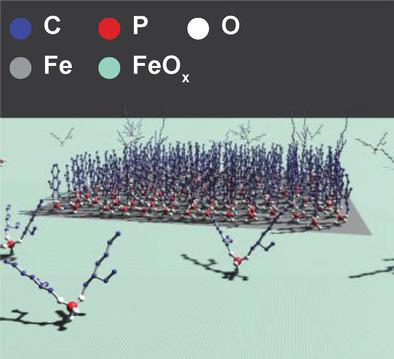当前位置:
X-MOL 学术
›
Adv. Mater. Interfaces
›
论文详情
Our official English website, www.x-mol.net, welcomes your feedback! (Note: you will need to create a separate account there.)
Lubrication Mechanism of Phosphonium Phosphate Ionic Liquid in Nanoscale Single‐Asperity Sliding Contacts
Advanced Materials Interfaces ( IF 5.4 ) Pub Date : 2020-07-12 , DOI: 10.1002/admi.202000426 Zixuan Li 1, 2 , Andrei Dolocan 1 , Oscar Morales‐Collazo 3 , Jerzy T. Sadowski 4 , Hugo Celio 1 , Robert Chrostowski 1, 2 , Joan F. Brennecke 3 , Filippo Mangolini 1, 5
Advanced Materials Interfaces ( IF 5.4 ) Pub Date : 2020-07-12 , DOI: 10.1002/admi.202000426 Zixuan Li 1, 2 , Andrei Dolocan 1 , Oscar Morales‐Collazo 3 , Jerzy T. Sadowski 4 , Hugo Celio 1 , Robert Chrostowski 1, 2 , Joan F. Brennecke 3 , Filippo Mangolini 1, 5
Affiliation

|
While phosphonium phosphate ionic liquids (ILs) have been evaluated as additives for engine oils owing to their excellent physico‐chemical properties, miscibility with hydrocarbon fluids, and promising tribological properties, their lubrication mechanism is still not established. Here, atomic force microscopy (AFM) nanotribological experiments are performed using diamond‐like carbon‐coated silicon tips sliding on air‐oxidized steel in neat trihexyltetradecylphosphonium bis(2‐ethylhexyl)phosphate IL. The AFM results indicate a reduction in friction only after the removal of the native oxide layer from steel. Laterally resolved analyses of the steel surface chemistry reveal a higher concentration of bis(2‐ethylhexyl)phosphate ions adsorbed on regions where the native oxide is mechanically removed together with a change in surface electrostatic potential. These surface modifications are proposed to be induced by a change in adsorption configuration of bis(2‐ethylhexyl)phosphate anions on metallic iron compared to their configuration on iron oxide together with a reduction of surface roughness, which lead to the formation of a densely packed, lubricious boundary layer only on metallic iron.
中文翻译:

纳米级单细孔滑动接触中磷磷酸盐离子液体的润滑机理
磷酸phospho离子液体(ILs)由于其出色的理化性质,与烃类流体的可混溶性以及有希望的摩擦学性能而被评估为发动机油的添加剂,但其润滑机理尚未建立。在这里,原子力显微镜(AFM)纳米摩擦学实验是使用在纯净的三己基十四烷基phosph双(2-乙基己基)磷酸酯IL中在空气氧化钢上滑动的类金刚石碳涂层硅尖端进行的。原子力显微镜的结果表明,只有从钢上去除天然氧化物层后,摩擦力才会降低。对钢表面化学成分的横向解析分析显示,较高浓度的双(2-乙基己基)磷酸根离子吸附在机械去除天然氧化物以及表面静电势发生变化的区域上。提议这些表面修饰是由于双(2-乙基己基)磷酸根阴离子在金属铁上的吸附构型与在氧化铁上的构型相比变化而引起的,并且表面粗糙度降低,从而导致形成致密堆积,仅金属铁上的润滑边界层。
更新日期:2020-09-11
中文翻译:

纳米级单细孔滑动接触中磷磷酸盐离子液体的润滑机理
磷酸phospho离子液体(ILs)由于其出色的理化性质,与烃类流体的可混溶性以及有希望的摩擦学性能而被评估为发动机油的添加剂,但其润滑机理尚未建立。在这里,原子力显微镜(AFM)纳米摩擦学实验是使用在纯净的三己基十四烷基phosph双(2-乙基己基)磷酸酯IL中在空气氧化钢上滑动的类金刚石碳涂层硅尖端进行的。原子力显微镜的结果表明,只有从钢上去除天然氧化物层后,摩擦力才会降低。对钢表面化学成分的横向解析分析显示,较高浓度的双(2-乙基己基)磷酸根离子吸附在机械去除天然氧化物以及表面静电势发生变化的区域上。提议这些表面修饰是由于双(2-乙基己基)磷酸根阴离子在金属铁上的吸附构型与在氧化铁上的构型相比变化而引起的,并且表面粗糙度降低,从而导致形成致密堆积,仅金属铁上的润滑边界层。


























 京公网安备 11010802027423号
京公网安备 11010802027423号